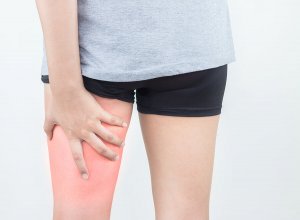The Hamstring Injury: All You Need To Know

As an athlete, it’s easy to ignore the muscles in the backs of your thighs. Nevertheless, suffering a hamstring injury is fairly common among active people. Because we use our legs for most high-intensity moves, it’s important to understand how to prevent and deal with this type of injury.
What are the hamstrings?
Of course, even if we say “hamstring”, this is in fact a set of muscles. There are three different muscles that work in unison. These three muscles are:
- Semimembranosus
- Semitendinosus
- Biceps femoris.
The hamstrings start in the pelvis. From there, they make their descent to the knee. The hamstrings are strong muscular fibers, with great contraction power.
Because of their key role in movements, it’s common to end a workout with a hamstring injury. In short, an athlete usually presents one of three types of hamstring injury: are contracture, rupture, and distention. By far, the latter is the most common injury in the thigh among athletes.
So what kinds of athletes are more prone to hamstring injuries? Most of the time, it’s the ones that use their lower body the most. Thus, soccer players, basketball players, and tennis players are at risk of developing injuries in the back of the thigh.
Of course, any physical activity that involves sudden bursts of activities and halts can injure these muscles.
Risk factors for a hamstring injury
As we said, the hamstring muscles can be at risk mainly among soccer, basketball and tennis athletes. If you practice other sports with an overload of the thigh muscles due to jumps or intense halts you might also be at risk.
However, there are other risk factors involved:
- Previous hamstring injuries: once muscles are injured, a lesion is more likely to recur. Because of this, rehabilitation is essential.
- Lack of flexibility: There are people who, congenitally, have less flexibility than others. This condition isn’t pathological but favors ligament and muscle strains.
- Muscle imbalance: Scientists and experts in sports science created this concept. In theory, an imbalance happens when a given muscle is overworked, while its opposite remains undertrained. This is very common in the thigh, where the quads are usually stronger than the hamstrings. As such, by having more force power in front of the thigh, that overload could injure the hamstrings.

Types of hamstring strains
The hamstring strain is the most frequent lesion of this muscle group. However, not all strains are the same. There are different levels of severity:
- First degree: this is basically a slight stretch. For the athlete, the symptoms are hardly a nuisance. However, this usually limits the mobility of the lower body. You can continue with your regular physical activity, and it’s even possible that the localized pain won’t become a nuisance until a few days after the injury. To treat first-grade hamstring stains, apply cold packs only.
- Second degree: this strain has a moderate severity. Beyond the stretching of muscle fibers, there are also tears or tears along the muscle fiber. Of course, it hurts more than the first-grade strain and can involve inflammation and edema. It’s common that as soon as the injury happens the athlete perceives it and has to stop the activity.
- Third degree: this is a serious injury. In this case, the muscle fibers are downright broken, and the injury resembles a tear. It might also include damage to the place where the tendons are inserted into the bones, which increases the severity. This strain greatly affects muscle movement ability, and pain interrupts any regular physical activity.
Treatment of a hamstring injury
To confirm a hamstring injury, your doctor will probably ask for an imaging test. This can be a soft tissue ultrasound or magnetic resonance. The technician looking at the test will look for changes in the muscle fibers. It’s also important to examine if they’re distended or broken.

Although symptoms can guide the medical diagnosis precisely in some cases, the imaging test is your best option to confirm. Once the existence of the injury is established, your doctor will propose a personalized treatment plan.
Nevertheless, here are some basic guidelines you can follow if you think you have a hamstring injury.
Basic guidelines
Of course, the first therapeutic measure is rest. Athletes must stop their training for at least a week. The severity of the injury will determine whether it’s necessary to continue resting.
After resting, applying a bandage, a local cold pack and maybe keeping your foot elevated might relieve the pain.
These measures should help with discomfort for the first week, which is usually the most intense. A medical professional can indicate an analgesic or anti-inflammatory on demand to ensure comfort.
When the pain disappears, the injured athlete might consider rehabilitation. This usually involves two parts. Initially, a specialist will work your entire muscle. Then, you’ll go over muscle training to strengthen the injured area. This will help muscle fibers recover their usual physiology.
On the other hand, in the second part, there’s reconditioning of the muscle for the specific sport. At this stage, there will be differences between the approach for a soccer player and a tennis player, for example.
Finally, we should mention that only very serious cases require surgical intervention. They’re exceptional and this isn’t frequent. Of course, if you suspect you’re going through a hamstring injury it’s best to consult a trusted physician.
As an athlete, it’s easy to ignore the muscles in the backs of your thighs. Nevertheless, suffering a hamstring injury is fairly common among active people. Because we use our legs for most high-intensity moves, it’s important to understand how to prevent and deal with this type of injury.
What are the hamstrings?
Of course, even if we say “hamstring”, this is in fact a set of muscles. There are three different muscles that work in unison. These three muscles are:
- Semimembranosus
- Semitendinosus
- Biceps femoris.
The hamstrings start in the pelvis. From there, they make their descent to the knee. The hamstrings are strong muscular fibers, with great contraction power.
Because of their key role in movements, it’s common to end a workout with a hamstring injury. In short, an athlete usually presents one of three types of hamstring injury: are contracture, rupture, and distention. By far, the latter is the most common injury in the thigh among athletes.
So what kinds of athletes are more prone to hamstring injuries? Most of the time, it’s the ones that use their lower body the most. Thus, soccer players, basketball players, and tennis players are at risk of developing injuries in the back of the thigh.
Of course, any physical activity that involves sudden bursts of activities and halts can injure these muscles.
Risk factors for a hamstring injury
As we said, the hamstring muscles can be at risk mainly among soccer, basketball and tennis athletes. If you practice other sports with an overload of the thigh muscles due to jumps or intense halts you might also be at risk.
However, there are other risk factors involved:
- Previous hamstring injuries: once muscles are injured, a lesion is more likely to recur. Because of this, rehabilitation is essential.
- Lack of flexibility: There are people who, congenitally, have less flexibility than others. This condition isn’t pathological but favors ligament and muscle strains.
- Muscle imbalance: Scientists and experts in sports science created this concept. In theory, an imbalance happens when a given muscle is overworked, while its opposite remains undertrained. This is very common in the thigh, where the quads are usually stronger than the hamstrings. As such, by having more force power in front of the thigh, that overload could injure the hamstrings.

Types of hamstring strains
The hamstring strain is the most frequent lesion of this muscle group. However, not all strains are the same. There are different levels of severity:
- First degree: this is basically a slight stretch. For the athlete, the symptoms are hardly a nuisance. However, this usually limits the mobility of the lower body. You can continue with your regular physical activity, and it’s even possible that the localized pain won’t become a nuisance until a few days after the injury. To treat first-grade hamstring stains, apply cold packs only.
- Second degree: this strain has a moderate severity. Beyond the stretching of muscle fibers, there are also tears or tears along the muscle fiber. Of course, it hurts more than the first-grade strain and can involve inflammation and edema. It’s common that as soon as the injury happens the athlete perceives it and has to stop the activity.
- Third degree: this is a serious injury. In this case, the muscle fibers are downright broken, and the injury resembles a tear. It might also include damage to the place where the tendons are inserted into the bones, which increases the severity. This strain greatly affects muscle movement ability, and pain interrupts any regular physical activity.
Treatment of a hamstring injury
To confirm a hamstring injury, your doctor will probably ask for an imaging test. This can be a soft tissue ultrasound or magnetic resonance. The technician looking at the test will look for changes in the muscle fibers. It’s also important to examine if they’re distended or broken.

Although symptoms can guide the medical diagnosis precisely in some cases, the imaging test is your best option to confirm. Once the existence of the injury is established, your doctor will propose a personalized treatment plan.
Nevertheless, here are some basic guidelines you can follow if you think you have a hamstring injury.
Basic guidelines
Of course, the first therapeutic measure is rest. Athletes must stop their training for at least a week. The severity of the injury will determine whether it’s necessary to continue resting.
After resting, applying a bandage, a local cold pack and maybe keeping your foot elevated might relieve the pain.
These measures should help with discomfort for the first week, which is usually the most intense. A medical professional can indicate an analgesic or anti-inflammatory on demand to ensure comfort.
When the pain disappears, the injured athlete might consider rehabilitation. This usually involves two parts. Initially, a specialist will work your entire muscle. Then, you’ll go over muscle training to strengthen the injured area. This will help muscle fibers recover their usual physiology.
On the other hand, in the second part, there’s reconditioning of the muscle for the specific sport. At this stage, there will be differences between the approach for a soccer player and a tennis player, for example.
Finally, we should mention that only very serious cases require surgical intervention. They’re exceptional and this isn’t frequent. Of course, if you suspect you’re going through a hamstring injury it’s best to consult a trusted physician.
All cited sources were thoroughly reviewed by our team to ensure their quality, reliability, currency, and validity. The bibliography of this article was considered reliable and of academic or scientific accuracy.
- Scarfó, Ricardo L. “Lesiones musculares: distensiones de los isquiotibiales.” Revista Digital. Buenos Aires 5.25 (2000).
- da Silva Dias, R., and A. Gómez-Conesa. Síndrome de los isquiotibiales acortados. Fisioterapia 30.4 (2008): 186-193.
- Domínguez-Gasca, Luis Gerardo, and Luis Gerardo Domínguez-Carrillo. Ruptura total de isquiotibiales mediales. Acta médica grupo Ángeles 9.4 (2011): 204-210.
This text is provided for informational purposes only and does not replace consultation with a professional. If in doubt, consult your specialist.








